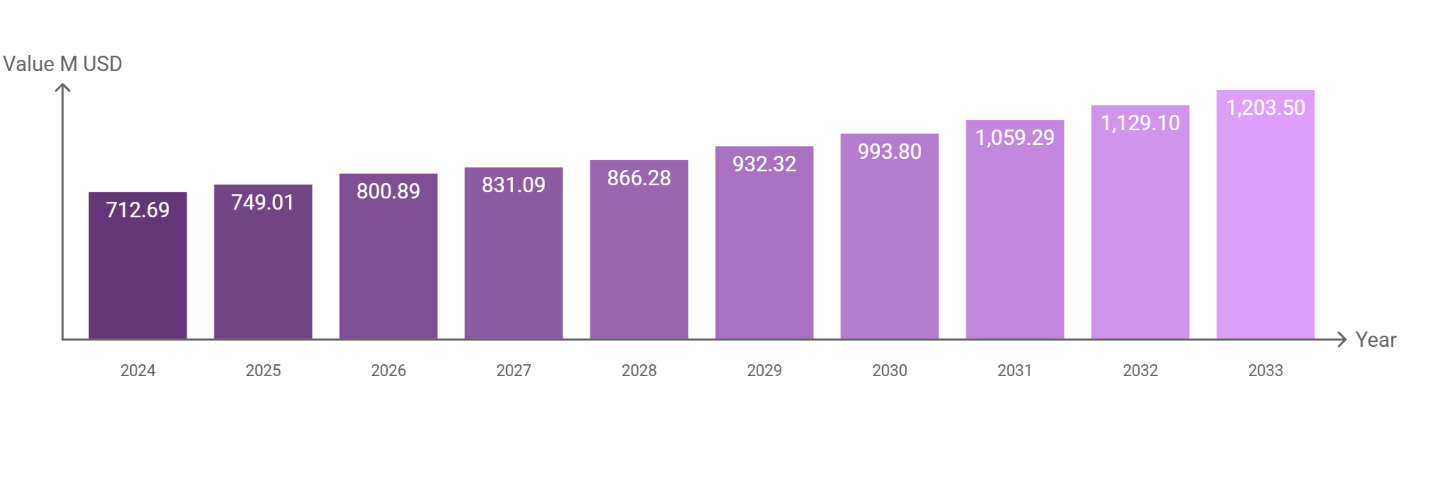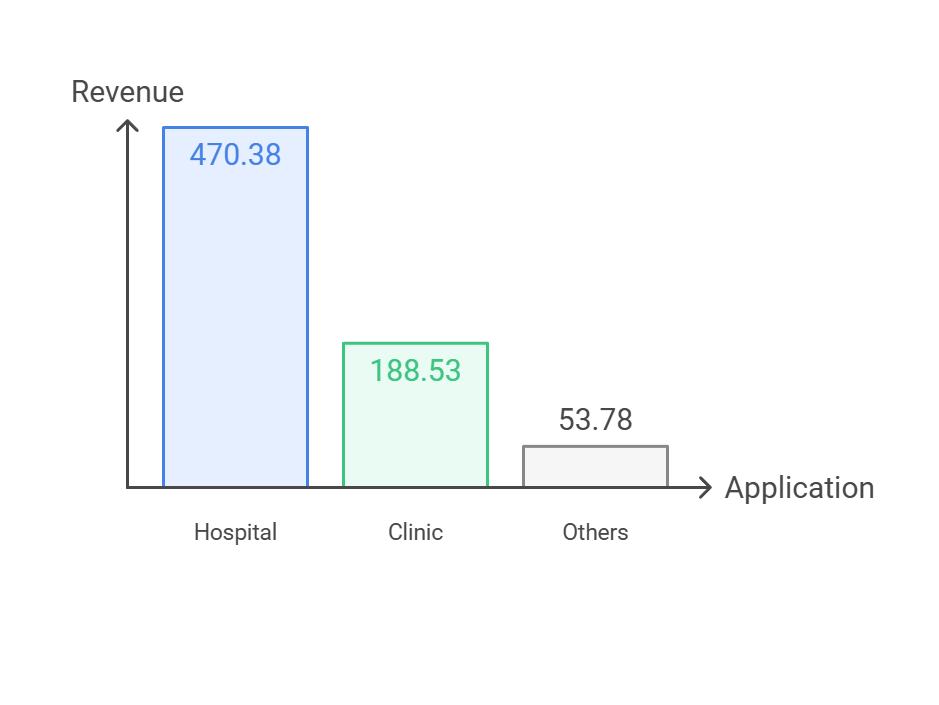1. Global X-ray Tables Market Overview
X-ray tables are specialized medical furniture designed for conducting diagnostic imaging procedures, particularly X-ray examinations. These tables are an essential component of radiology and medical imaging departments in healthcare facilities. They provide a stable and adjustable platform for patients to lie on during the imaging process, allowing medical professionals to obtain clear and accurate X-ray images.
The global X-ray Tables market is projected to exhibit a robust growth trajectory, with revenues increasing from $712.69 million in 2024 to an estimated $1,203.50 million by 2033, at a compound annual growth rate (CAGR) of 5.98%. This steady growth can be attributed to the expanding healthcare industry, technological advancements in medical imaging, and the rising geriatric population globally, which contributes to a higher demand for diagnostic procedures. The CAGR indicates a consistent expansion in the market, suggesting that the X-ray Tables segment is likely to maintain its growth momentum, influenced by continuous innovation in healthcare and the need for advanced medical equipment.
Figure Global X-ray Tables Market Size (M USD) Outlook (2024-2033)

2. X-ray Tables Market Dynamics
Table X-ray Tables Market Drivers in Global Market
| Item |
|
X-ray Tables product advantages | X-ray Tables consist of a flat table surface and one or more supporting and fixing devices. It allows patients to position and maintain their posture correctly for accurate imaging. X-ray Tables products have several advantages that make this product widely used, including stability, durability, safety, ease of cleaning, and more. First of all, X-ray Tables usually have a flatbed surface, reliable support equipment, and transparent bed surface materials to ensure stability and durability without affecting the penetration of X-rays. Secondly, X-ray Tables meet safety designs, such as anti-slip materials, protective devices, etc., to ensure the safety of patients and operators. Some adjustable or removable parts add to the convenience of X-ray Tables, allowing them to be moved or adjusted as needed. Additionally, the surfaces of X-ray Tables are typically smooth and easy to clean and disinfect. This is very important because medical equipment needs to be cleaned frequently to meet safety and hygiene standards. |
Development and applications of X-rays. | X-rays are a quick, painless test that produces images of structures inside the body, especially bones. An X-ray beam passes through the patient’s body and will be absorbed in varying amounts depending on the density of the material the X-rays pass through. Dense materials such as bone and metal appear white on X-rays. The air in the lungs appears black. Fat and muscle appear in shades of gray. For some types of X-rays, doctors may inject a contrast agent (such as iodine or barium) into the patient to provide more detail in the image. Based on this principle, X-rays can be used to examine multiple parts of the body, including bones and teeth, the chest and abdomen. In bone and tooth diagnosis, fractures and infections, arthritis, dental caries, osteoporosis, and bone tumors can be revealed. In chest diagnostics, X-rays can be used to detect lung infections or lung conditions, breast cancer, heart enlargement, and blocked blood vessels. For abdominal diagnosis, X-rays can reveal swallowed foreign objects or, with the help of contrast media, problems in the digestive tract.X-rays help diagnose and treat diseases, and the technology is mature. X-rays are of great significance to the research and clinical practice of medical imaging. X-ray Tables are used in X-ray equipment to help doctors obtain accurate pictures. The widespread use of X-ray technology in medicine has promoted the use of X-ray Tables, thereby boosting the growth of the industry. |
Table X-ray Tables Market Restraints in Global Market
| Item | Description |
Unnecessary exposure to X-rays. | Although X-rays are extremely useful in diagnosis, there are cases where improper use can result in unnecessary exposure. The reasons may be manifold. First of all, safety operations under the principles of legitimacy and optimization of medical exposure have not been taken seriously, and the abuse of X-ray inspection items still exists. For example, a study conducted in the UK estimated that up to 20% of medical X-rays are unhelpful. Secondly, the positive rate of radiological diagnosis is low, and protective measures for operators and patients are not implemented, which may lead to unnecessary exposure. Additionally, in some developing countries, poor image quality and a lack of experienced radiotherapists is a reasons for repeated X-ray examinations. Although the dose of X-rays used for clinical purposes is relatively low, as the number of people exposed to these radiations multiple times throughout their lives continues to increase, any unnecessary imaging may lead to some health-related problems in the future. The use of X-rays is increasing rapidly, but if unnecessary exposure cannot be effectively controlled, it may cause health risks and thus limit the normal use of X-ray technology. |
Patients have insufficient knowledge of X-rays. | Adequate notification obligations for X-ray diagnosis and treatment should include both diagnostic benefits and radiation risks to guide patients to effectively participate in the clinical decision-making process. However, due to the tendency of doctors to avoid seeking informed consent, this obligation to inform is often insufficiently implemented, resulting in many patients having misunderstandings or insufficient understanding of X-rays. X-rays are often used for medical diagnosis or treatment of patients, or for biomedical research. In these circumstances, the patient’s benefit from radiation exposure is expected to outweigh any radiation harm to the recipient. For these situations, adequate radiation protection systems are already in place. Insufficient patient understanding usually results in two aspects. For one thing, people often worry about being exposed to radiation when getting X-rays because of radiation injury scares. Such sentiments may lead patients to refuse testing due to the very small risk of cancer. On the other hand, unnecessary exposure may result. |
3. X-ray Tables Analysis by Type
Adjustable: One of Adjustable table main features is the absence of longitudinal brace at the front of the leg frame, allowing the free positioning of a C-arm.
Mobile: The Mobile Table is an X-ray table with four 360-degree swivel locking casters so it can move with patients and staff.
In 2024, the adjustable type is projected to generate a revenue of $473.21 million USD, while the mobile type is forecasted to yield $239.48 million USD. Both types of X-ray tables have a sizable market share, with the adjustable type taking a larger share, likely due to its versatility in meeting a variety of patient positions and imaging needs. The mobile type is still important despite its smaller revenue contribution, reflecting the importance of mobility in healthcare settings to facilitate patient transportation and room-to-room imaging capabilities.
Figure Global X-ray Tables Revenue (M USD) and Market Share by Type in 2024

4. X-ray Tables Analysis by Application
X-ray tables have been specially developed for use in the X-ray field. It is commonly used in medical practices such as hospitals, clinics, and others. Others include veterinary hospitals, etc.
In 2024, the global X-ray Tables market revenue by application segment is distributed as follows: Hospitals with $470.38 million USD, Clinics with $188.53 million USD, and Others with $53.78 million USD. The Hospital segment is anticipated to generate the highest revenue, contributing significantly to the overall market. This is attributed to the widespread use of X-ray tables in hospitals for various diagnostic procedures and the constant demand for advanced medical imaging equipment in these settings. The Clinic segment also plays a notable role, reflecting the increasing need for X-ray facilities in outpatient care centers.
Collectively, these applications represent the diverse utility and necessity of X-ray tables across different healthcare facilities, underscoring their importance in modern medical diagnostics.
Figure Global X-ray Tables Revenue (M USD) and Market Share by Application in 2024

5. Global X-ray Tables Market Size by Region
In 2024, North America is projected to generate a revenue of $157.58 million USD, Europe is estimated to reach $243.60 million USD, Asia Pacific is anticipated to contribute $274.14 million USD, South America is forecasted to have a revenue of $26.16 million USD, and the Middle East and Africa are expected to bring in $11.21 million USD.
The regional market with the greatest development potential is the Asia-Pacific market. This region not only holds a substantial market share but also demonstrates a robust growth trajectory, which can be attributed to the rapid development of the healthcare sector, increasing demand for advanced medical imaging equipment, and the growing patient population in countries like China and India.
Table By Region – Global X-ray Tables Revenue, (M USD)
| 2024 |
North America | 157.58 |
Europe | 243.60 |
Asia Pacific | 274.14 |
South America | 26.16 |
Middle East and Africa | 11.21 |
Total | 712.69 |
6. Global X-ray Tables Market by Major Players
The top three companies in the global X-ray table market are Siemens, GE, and Philips.
Siemens leads with a revenue of $185.18 million USD, maintaining its position as the market leader with a 25.99% share, followed by GE with a revenue of $145.54 million USD and a 20.42% market share. Philips secures the third position with a revenue of $115.33 million USD, holding a 16.18% share of the market. These companies collectively contribute substantially to the overall market revenue, reflecting their dominance and influence in the global X-ray Tables industry. Their continued investment in innovation, product development, and market expansion strategies positions them as key players shaping the trajectory of the market.
Table Top X-ray Tables Players in Global Market, by Revenue (M USD) (2024)
| Revenue (M USD) | Market Share |
Siemens | 185.18 | 25.99% |
GE | 145.54 | 20.42% |
Philips | 115.33 | 16.18% |





